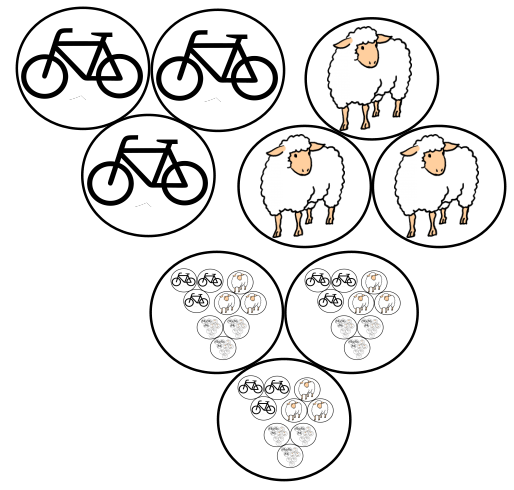Are you ready for Invisible XML?
Steven Pemberton, CWI, Amsterdam

 Numbers are
abstractions: you can't point to the number three, just three bicycles, or
three sheep, or three self-referential examples.
Numbers are
abstractions: you can't point to the number three, just three bicycles, or
three sheep, or three self-referential examples.
Three is what those bicycles and sheep and examples have in common.
You can represent a number in different ways:
3, III, 0011, ㆔, ३, ፫, ૩, ੩, 〣, ೩, ៣, ໓, Ⅲ, ൩, ၃, ႓, trois, drie.
You can concretise numbers as a length, a weight, a speed, a temperature.
But in the end, they all represent the same three.
We are often obliged for different reasons to represent data in some way or another, but in the end those representations are all of the same abstraction; there is no essential difference between the JSON
{"temperature": {"scale": "C"; "value": 21}}
and an equivalent XML
<temperature scale="C" value="21"/>
or
<temperature> <scale>C</scale> <value>21</value> </temperature>
or indeed
temperature: 21°C
since the underlying abstractions being represented are the same.
Takes a representation of data (typically with implicit structure).
Uses a description of the format of that data to recognise the data's structure.
Creates an internal representation of the data, now with the structure made explicit.
Which can be used for multiple purposes, including creating an external representation with explicit structure.
Some representations are weaker than others: they may not be able to faithfully represent all of the abstraction, and are therefore not reversible.
XML is probably the best available general notation for generating the representation of any abstraction.
The intention behind ixml is to allow extracting abstractions from representations; of converting weaker representations of abstractions into stronger ones, with XML therefore an excellent target for that.
Input: 5 December 2023
Describe the format:
date: day, " ", month, " ", year. day: digit, digit?. month: "January"; "February"; ...; "December". year: digit, digit, digit, digit. digit: ["0"-"9"].
Input: 5 December 2023
Describe the format:
date: day, " ", month, " ", year. day: digit, digit?. month: "January"; "February"; ...; "December". year: digit, digit, digit, digit. digit: ["0"-"9"].
Process the input with this description, and get:
<date>
<day>
<digit>5</digit>
</day>
<month>December</month>
<year>
<digit>2</digit>
<digit>0</digit>
<digit>2</digit>
<digit>3</digit>
</year>
</date>
Input: 5 December 2023
Describe the format:
date: day, " ", month, " ", year. day: digit, digit?. month: "January"; "February"; ...; "December". year: digit, digit, digit, digit. -digit: ["0"-"9"].
Process the input with this description, and get:
<date> <day>5</day> <month>December</month> <year>2023</year> </date>
Add another format option: 5/12/2023
Add to the description:
date: day, " ", month, " ", year;
day, "/", nmonth, "/", year.
day: digit, digit?.
month: "January"; "February"; ...; "December".
nmonth: digit, digit?.
year: digit, digit, digit, digit.
-digit: ["0"-"9"].
Process the input with this description, and get:
<date> <day>5</day>/ <nmonth>12</nmonth>/ <year>2023</year> </date>
dates: date+.
dates: date+.
Better:
dates: (date, " "*)+.
dates: date+.
Better:
dates: (date, " "*)+.
or:
dates: date++", ".
for input like:
19/10/2022, 31 December 2023, 1/1/2024
Input: 5/12/2023
date: day, " ", month, " ", year;
day, "/", nmonth, "/", year.
day: digit, digit?.
month: "January"; "February"; ...; "December".
nmonth: digit, digit?.
year: digit, digit, digit, digit.
-digit: ["0"-"9"].
gives:
<date> <day>5</day>/ <nmonth>12</nmonth>/ <year>2023</year> </date>
Input: 5/12/2023
date: day, " ", month, " ", year;
day, "/", nmonth, "/", year.
@day: digit, digit?.
@month: "January"; "February"; ...; "December".
@nmonth: digit, digit?.
@year: digit, digit, digit, digit.
-digit: ["0"-"9"].
gives
<date day="5" nmonth="12" year="2023">//</date>
Input: 5/12/2023
date: day, -" ", month, -" ", year;
day, -"/", nmonth, -"/", year.
@day: digit, digit?.
@month: "January"; "February"; ...; "December".
@nmonth: digit, digit?.
@year: digit, digit, digit, digit.
-digit: ["0"-"9"].
gives
<date day="5" nmonth="12" year="2023"/>
A grammar accepting both World and USA style dates, with month only 1-12, and day 1-31:
date: us; world.
us: month, -"/", day, -"/", year.
world: day, -"/", month, -"/", year.
month: "0"?, ["1"-"9"];
"10"; "11"; "12".
etc
the input 31/12/2023 would produce:
<date xmlns:ixml="http://invisiblexml.org/NS">
<world>
<day>31</day>
<month>12</month>
<year>2023</year>
</world>
</date>
A grammar accepting both World and USA style dates, with month only 1-12, and day 1-31:
date: us; world.
us: month, -"/", day, -"/", year.
world: day, -"/", month, -"/", year.
month: "0"?, ["1"-"9"];
"10"; "11"; "12".
etc
the input 12/31/2023 would produce:
<date xmlns:ixml="http://invisiblexml.org/NS">
<us>
<month>12</month>
<day>31</day>
<year>2023</year>
</us>
</date>
A grammar accepting both World and USA style dates, with month only 1-12, and day 1-31:
date: us; world.
us: month, -"/", day, -"/", year.
world: day, -"/", month, -"/", year.
month: "0"?, ["1"-"9"];
"10"; "11"; "12".
etc
the input 5/12/2023 would produce:
<!-- AMBIGUOUS
The input from line.pos 1.1 to 1.11 can be interpreted as 'date' in 2 different ways:
1: us[:1.11]
2: world[:1.11]
-->
<date ixml:state="ambiguous" xmlns:ixml="http://invisiblexml.org/NS">
<us>
<month>5</month>
<day>12</day>
<year>2023</year>
</us>
</date>
url: scheme, ":", authority, path.
scheme: letter+.
authority: "//", host.
host: sub++".".
sub: letter+.
path: ("/", seg)+.
seg: fletter*.
-letter: ["a"-"z"]; ["A"-"Z"]; ["0"-"9"].
-fletter: letter; ".".
Result for http://w3.org/1999/xhtml.html:
<url>
<scheme>http</scheme>:
<authority>//
<host>
<sub>w3</sub>.
<sub>org</sub>
</host>
</authority>
<path>
/<seg>1999</seg>
/<seg>xhtml.html</seg>
</path>
</url>
url: scheme, ":", authority, path.
@scheme: letter+.
authority: "//", host.
host: sub++".".
sub: letter+.
path: ("/", seg)+.
seg: fletter*.
-letter: ["a"-"z"]; ["A"-"Z"]; ["0"-"9"].
-fletter: letter; ".".
Result for http://w3.org/1999/xhtml.html:
<url scheme="http">:
<authority>//
<host>
<sub>w3</sub>.
<sub>org</sub>
</host>
</authority>
<path>
/<seg>1999</seg>
/<seg>xhtml.html</seg>
</path>
</url>
url: scheme, ":", authority, path.
@scheme: letter+.
authority: "//", host.
host: sub++".".
-sub: letter+.
path: ("/", seg)+.
-seg: fletter*.
-letter: ["a"-"z"]; ["A"-"Z"]; ["0"-"9"].
-fletter: letter; ".".
Result for http://w3.org/1999/xhtml.html:
<url scheme="http">:
<authority>//
<host>w3.org</host>
</authority>
<path>1999/xhtml.html</path>
</url>
url: scheme, -":", authority, path.
@scheme: letter+.
authority: -"//", host.
host: sub++".".
-sub: letter+.
path: ("/", seg)+.
-seg: fletter*.
-letter: ["a"-"z"]; ["A"-"Z"]; ["0"-"9"].
-fletter: letter; ".".
Result for http://w3.org/1999/xhtml.html:
<url scheme="http">
<authority>
<host>w3.org</host>
</authority>
<path>1999/xhtml.html</path>
</url>
The hardest part of getting an article into Docbook format (the format used by several conferences I go to) is getting the bibliography right.
The bibliography for a recent paper was produced with the help of ixml. For instance, the text
[spec] Steven Pemberton (ed.), Invisible XML Specification, invisiblexml.org,
2022, https://invisiblexml.org/ixml-specification.html
was processed by an ixml grammar whose top-level rules were
bibliography: biblioentry+.
biblioentry:
abbrev, (author; editor), -", ",
title, -", ",
publisher, -", ", pubdate, -",",
(artpagenums, -", ")?,
(bibliomisc; biblioid)**-", ", -#a.
<biblioentry>
<abbrev>spec</abbrev>
<editor>
<personname>
<firstname>Steven</firstname>
<surname>Pemberton</surname>
</personname>
</editor>
<title>Invisible XML Specification</title>
<publisher>invisiblexml.org</publisher>
<pubdate>2022</pubdate>
<bibliomisc>
<link xl-href='https://invisiblexml.org/ixml-specification.html'/>
</bibliomisc>
</biblioentry>
Similarly, users at a large American academic library are using ixml to process OCR'd bibliographies to extract the structure.
Invisible XML has greater expressive power than regular expressions.
This makes it great for extracting information from existing textual documents.
The input data doesn't have to be line-based to extract information.
There is a project in the Dutch Government using ixml for just this, to locate particular information within large document collections.
The ixml community is producing a library of grammars for a number of standard formats.
For instance, there is a grammar for (a subset of) Markdown: I recently used it to produce a chapter of a book.
 An ixml processor takes a document in a particular
(textual) format, along with a description of that format, in the form of a
grammar, and uses it to parse the document.
An ixml processor takes a document in a particular
(textual) format, along with a description of that format, in the form of a
grammar, and uses it to parse the document.
This produces a structured parse tree, which can then be processed in a number of ways, such as serialization as XML.
 The
format description is drawn as a structured document.
The
format description is drawn as a structured document.
However, it is normally supplied in textual form, and is processed in exactly the same way, by the ixml processor, but using a description of the ixml format.
This results in the structured version of the description.

ixml is of course expressed in ixml:
rule: (mark, s)?, name, s, -["=:"], s, -alts, -".".
which comes out as XML
<rule name='rule'>
<alt>
<option>
<alts>
<alt>
<nonterminal name='mark'/>
<nonterminal name='s'/>
</alt>
</alts>
</option>
<nonterminal name='name'/>
<nonterminal name='s'/>
<inclusion tmark='-'>
<member string='=:'/>
</inclusion>
<nonterminal name='s'/>
<nonterminal mark='-' name='alts'/>
<literal tmark='-' string='.'/>
</alt>
</rule>

What many miss on first introduction to ixml is the essential role of the abstract document in the middle: everything else is just representation.
The ixml description language plays three roles:
There are two online interactive hands-on tutorials available, with exercises:
The specification: as specifications go, rather readable, and should answer any questions you have about how it works.
Version 1 was officially released in 2022 on invisiblexml.org
Currently 4 implementations running, 4 more in preparation.
For full details pop along to the ixml website, and join the working group if you want.